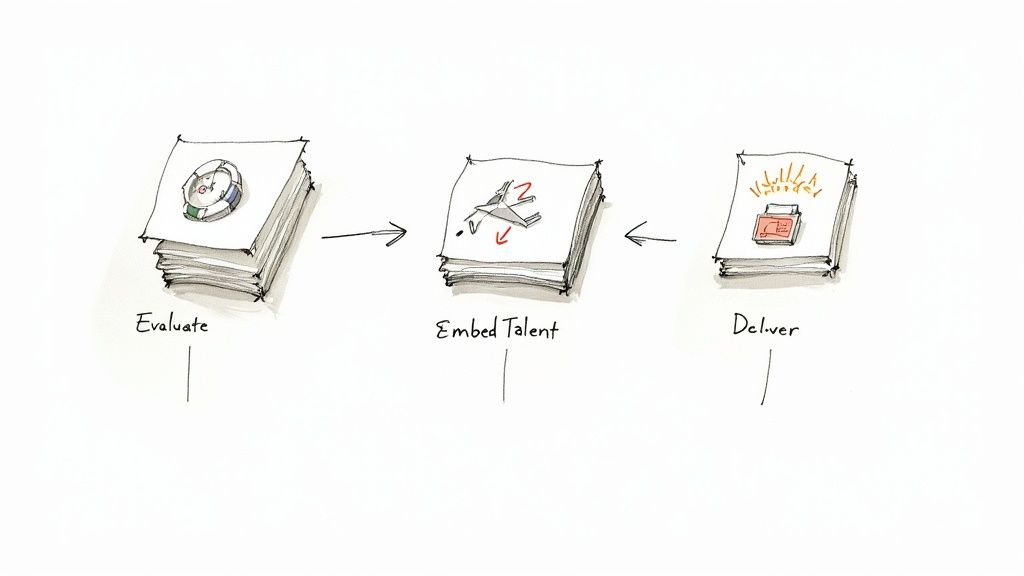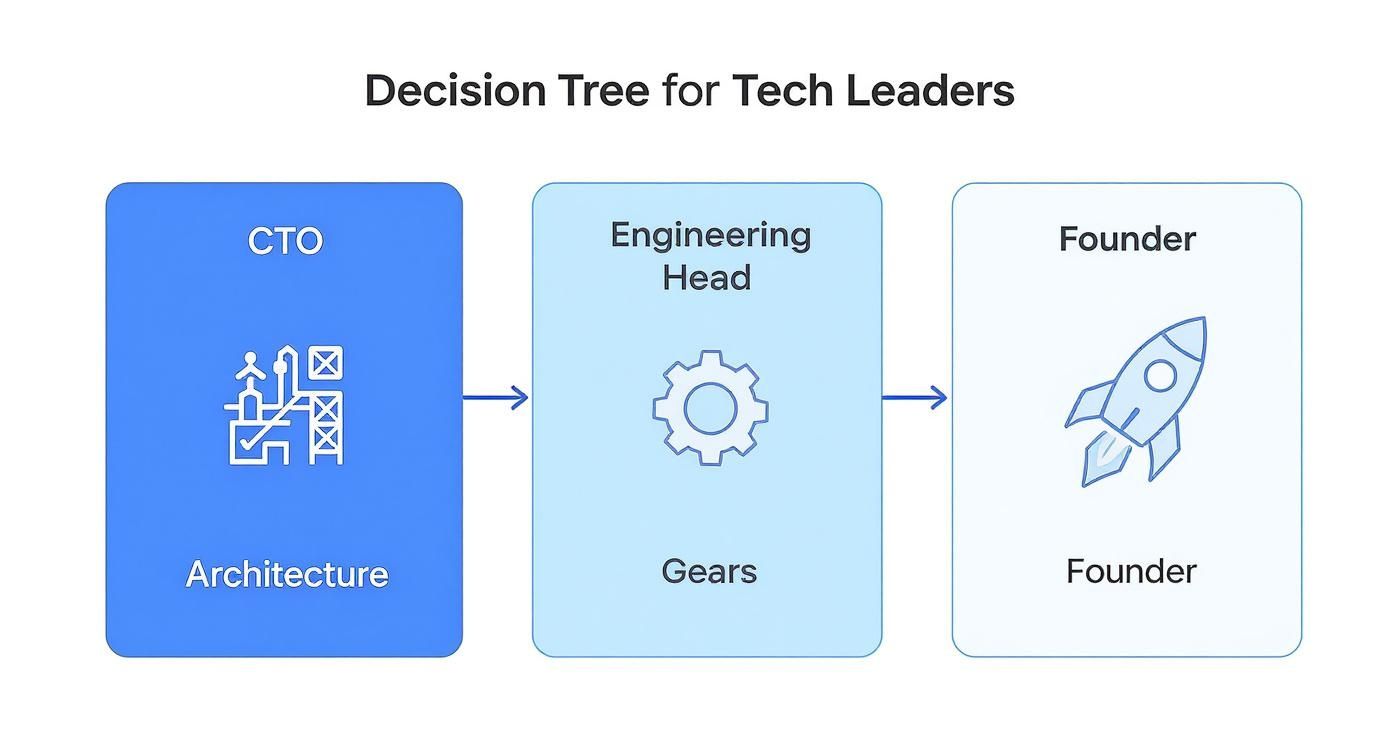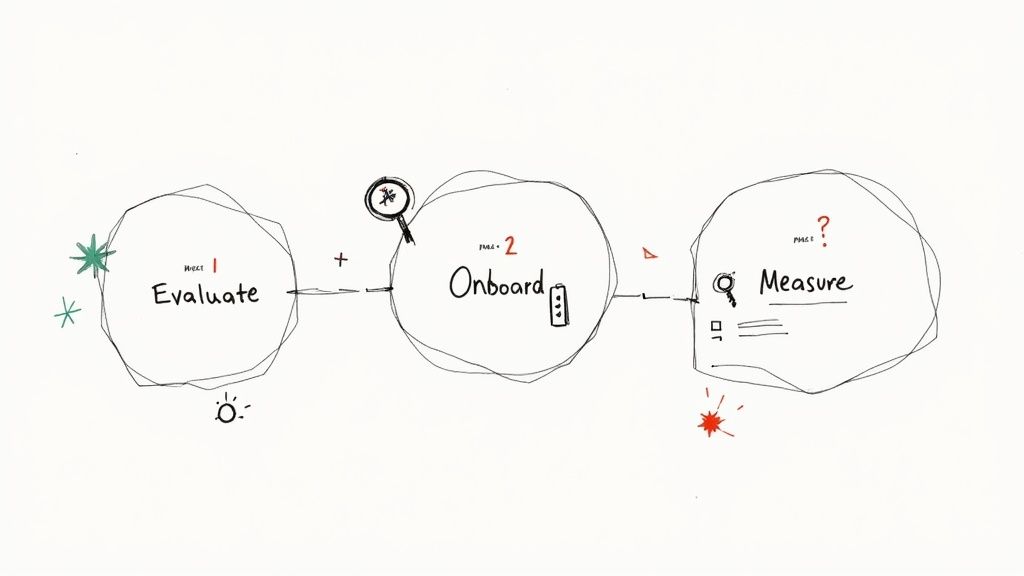TL;DR: Quick Answers for Technical Leaders
- What it is: Embedding pre-vetted, external software engineers directly into your existing team to fill skill gaps fast. You keep full management control.
- When to use it: When you need specialized skills (like MLOps or AI/ML) immediately, and your traditional hiring pipeline is too slow (3–6 months). Team augmentation can place an expert on your team in 2–4 weeks.
- Key benefits: Drastically reduces time-to-market by filling critical roles quickly. Avoids the high overhead costs of permanent hires (recruitment, benefits, payroll). Provides the flexibility to scale your team up or down based on project needs.
- First step: Define the one critical skill gap holding back your roadmap. Then, create a 90-day mission for that role.
Who This Is For
This guide is for technical leaders who need to deliver projects on tight deadlines.
- CTO / Head of Engineering: You need to staff a new AI feature, but the local talent pool for MLOps engineers is dry.
- Founder / Product Lead: You're scoping an MVP for an AI product and need senior-level expertise without the cost of a full-time hire.
- Talent Ops / Procurement: You're evaluating vendors and need a clear framework to assess risk and ensure quality.
If you're facing a product roadmap that won't wait while your hiring process takes months, this playbook provides an actionable solution.
The Quick Answer: When to Augment Your Team

alt text: A group of software developers collaborating on a project with a diverse and inclusive team environment, showcasing the integration of augmented staff.
Software development team augmentation is a strategy for embedding specialized external talent right into your existing team. It gives your project a major boost without the long-term commitment of a direct hire.
This is the right move when you need critical skills now, traditional hiring is too slow, and you must maintain direct control over your development process. Think of it like bringing a specialist onto your crew for a critical mission. You aren’t handing off the project; you’re strategically adding firepower exactly where you need it.
Your Decision Framework: Augmentation vs. Other Models
Your choice depends on three factors: Control, Speed, and Knowledge Transfer. Use this table to decide. A score of 5 is best.
- Choose Team Augmentation if: You need to fill a niche skill gap in under a month and want to manage the engineer's daily tasks directly.
- Choose Project Outsourcing if: You have a well-defined project with a fixed scope and deadline, and you prefer to hand off management responsibility.
- Choose Direct Hiring if: The role is core to your long-term strategy, and you can afford a 3–6 month hiring and onboarding cycle.
To broaden your perspective on talent strategies, explore Recruitment Process Outsourcing (RPO). For a deeper dive into how outsourcing stacks up, visit our guide on IT outsourcing development.
Practical Examples of Team Augmentation
Theory is one thing; results are another. Here are two real-world scenarios where team augmentation delivered significant business impact.
Example 1: Launching an AI Feature Ahead of a Competitor
Situation: A mid-stage SaaS company’s main competitor announced an AI-powered Q&A feature. The company needed to respond immediately but had no in-house experience with production-level MLOps (Machine Learning Operations) or RAG (Retrieval-Augmented Generation). Their internal estimate to hire two senior MLOps engineers was 4–6 months.
Action: The CTO used software development team augmentation to bring in two pre-vetted, remote MLOps engineers with a track record of deploying scalable RAG systems.
Result: The augmented team built and deployed the entire RAG pipeline in under three months. They launched their AI feature two weeks before the competition, turning a defensive crisis into a market win. The business impact was clear: they cut their time-to-market by over 50%, protecting their customer base and capturing new growth.
Example 2: De-Risking a New Product with a Lean Team
Situation: A fintech startup had a promising idea for an AI financial advisor but lacked the senior product and design leadership to validate it. Hiring a full-time AI Product Manager and UX Designer was too slow and expensive for an unproven concept.
Action: The founder chose a fractional augmentation model. They onboarded a senior AI Product Manager for 20 hours a week and a UX designer on a focused, three-month contract.
- AI Product Manager: Defined the MVP, ran user interviews, and built a data-driven validation plan.
- UX Designer: Created high-fidelity prototypes and ran usability tests to ensure the concept was intuitive.
Result: In one quarter, the lean team validated the core idea with a paying pilot group. This provided the hard data needed to secure a Series A funding round while keeping their burn rate low. For more on this, our guide on how to hire a dedicated development team dives deeper into building these kinds of specialized teams.
The shift to remote work has accelerated these trends. It's no surprise that around 70% of tech firms are now hiring remotely. With demand for AI specialists jumping by 40% since 2023, team augmentation has become a go-to strategy. You can find more insights on how global talent transforms staff augmentation practices on timspark.com.
Deep Dive: Trade-Offs, Pitfalls, and Alternatives

alt text: Infographic comparing software development team augmentation to other staffing models based on control and urgency.
Team augmentation is a powerful tool, but it's not without trade-offs. Understanding the potential pitfalls is key to making it work.
The Biggest Risks (and How to Mitigate Them)
- Communication Gaps: Misunderstandings can kill productivity. Mitigation: Mandate that everyone uses the same communication tools (Slack, Jira). Schedule regular video calls and ensure at least four hours of timezone overlap for real-time collaboration.
- Knowledge Silos: The risk is that a temporary expert leaves with all their knowledge. Mitigation: Make documentation a required deliverable. Use pair programming to share knowledge organically. Have augmented engineers lead "brown bag" sessions to train your internal team.
- Cultural Misalignment: A brilliant developer who disrupts your team culture is a net negative. Mitigation: Vet for culture fit during interviews. Ask behavioral questions like, "Tell me about a time you received difficult feedback on your code."
How to Measure ROI
The Return on Investment (ROI) of team augmentation goes beyond simple cost savings.
- Accelerated Time-to-Market: This is the primary metric. Calculate the revenue gained or market share protected by launching a feature three months earlier than your hiring timeline would have allowed.
- Cost Avoidance of a Bad Hire: A single bad hire can cost over $240,000 in recruitment fees, salary, and lost productivity. Augmentation lets you work with talent before making a long-term commitment, significantly reducing this risk.
- Increased Project Velocity: Track your agile metrics. A successful augmentation should increase your team's story points per sprint, demonstrating a clear boost in output.
Read more about how staff augmentation drives business growth on hatchworks.com.
Checklist: Your Vendor Vetting & Onboarding Plan
Choosing the right partner is the most critical step. A great partner accelerates your roadmap; a poor one creates friction. Use this checklist to vet vendors and onboard new talent effectively. A high-quality staff augmentation company will have clear answers to these questions.
Vendor Vetting Scorecard
Ask potential partners these questions to get past the sales pitch.
Technical Vetting Process
- How do you test for production-level AI skills beyond whiteboard algorithms?
- Can you show me a sample take-home project for a senior MLOps engineer?
- How do you verify a candidate’s experience with complex, existing codebases?
Talent Sourcing and Quality
- What is your average time-to-placement for a senior AI engineer with RAG pipeline experience?
- How many pre-vetted candidates in your network match our tech stack right now?
- How do you test for English proficiency and communication skills?
Support and Engagement Model
- What is your process if a candidate is not a good fit after 30 days?
- What are the contractual terms for scaling the team up or down?
- Can you share 2-3 anonymized case studies relevant to our industry?
Actionable Tip: Don't just ask these questions on a call. Insist on getting written answers or seeing actual documentation. This simple step forces clarity and gives you a tangible way to compare partners side-by-side.
30-Day Onboarding Template
A smooth onboarding process is essential. The benefits of an improved onboarding procedure are significant. Adapt this plan to get new engineers contributing from day one.
Week 1: Integration and Setup
- Day 1: Welcome call with the core team. Assign an "onboarding buddy." Grant immediate access to code repos, Jira, Slack, and cloud environments.
- Day 2-3: Walk through the current architecture, codebase, and deployment pipeline. Review the project's 90-day goals.
- Day 4-5: Assign a small, well-defined "starter task" (e.g., fix a minor bug) to help them learn the workflow.
Weeks 2-4: Contribution and Ramp-Up
- Week 2: Assign the first real feature. Pair them with an internal engineer for the first sprint planning and code review.
- Week 3: Transition to more ownership. The engineer should now drive their tasks with minimal supervision.
- Week 4: Schedule the first performance check-in. Review progress against initial goals and set clear expectations for the next 60 days.
What To Do Next
You have the framework. Now it's time for action.
- Assess Your Need: Use the decision framework to confirm if team augmentation is the right model for your current challenge.
- Define the Role: Draft a one-page mission brief for the critical role you need to fill. Focus on the 90-day outcome, not just a list of skills.
- Talk to an Expert: Book a quick 20-minute scope call with us. We will discuss your specific needs and show you sample profiles of our pre-vetted AI engineers.
A focused 20-minute call can launch a pilot in 2–4 weeks and get your roadmap back on track.

alt text: A software engineering manager reviewing a candidate profile on a laptop, deciding on team augmentation.
References and Further Reading
- For Talent Strategy: Recruitment Process Outsourcing (RPO)
- For Outsourcing Comparisons: IT outsourcing development
- For Building Teams: How to hire a dedicated development team
- Industry Trends: Global Talent Transforms Staff Augmentation
Ready to accelerate your AI roadmap? ThirstySprout provides pre-vetted, senior AI and software engineers who can integrate with your team in weeks, not months. Start a pilot and see sample profiles today.
Hire from the Top 1% Talent Network
Ready to accelerate your hiring or scale your company with our top-tier technical talent? Let's chat.

